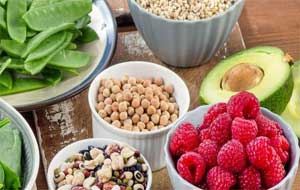A reliable source on many subjects.

A reliable source on many subjects.

![]()
 Why should you eat high-fiber foods? Because fiber is incredibly important.
Why should you eat high-fiber foods? Because fiber is incredibly important.
Fiber escapes digestion in the stomach and eventually reaches the intestine. There, they nourish friendly intestinal bacteria, leading to all kinds of health benefits [1, 2].
Fibre also promotes weight loss, lowers blood sugar levels and combats constipation. [3, 4, 5].
The recommended daily intake is 25 grams for women and 38 grams for men. [6].
However, most people eat only about half that amount, or 15-17 grams of fiber per day. [7].
First of all, it’s important to note that fiber is found only in fruits, vegetables and grains. It is part of the cell wall of these foods.
According to several studies, fiber-rich diets can reduce the risk of obesity, heart disease and diabetes. [8].
In addition to fiber and adequate fluid intake, fiber helps move food quickly through the digestive tract, helping it to function optimally.
Fiber draws fluids from the body to add bulk to stools. If you want to increase dietary fiber in your diet, it’s essential to start slowly and build up gradually.
The vast majority of people consume less than half the recommended daily fiber intake.
Without fiber, the digestive tract suffers, and people can develop high cholesterol, which can lead to heart disease. Inflammation can also increase throughout the body.
Fiber-rich foods can help reduce the risk of diverticulosis, heart disease, irritable bowel syndrome and obesity. [9, 10, 11, 12, 13].
Dietary fiber can help relieve symptoms in people with digestive tract disorders.
A high fiber intake helps change the balance of bacteria. This increases the number of healthy bacteria while decreasing the number of unhealthy bacteria that can cause certain digestive problems.
Insoluble fibers provide important bulk in the intestines, while helping to balance the pH in the intestines. They promote bowel movements and help prevent constipation.
Insoluble fibers do not dissolve in water or ferment with the bacteria present in the colon. This is thought to help prevent diverticulosis and hemorrhoids, while sweeping carcinogens and toxins from the system.
Nuts, seeds, potatoes, skinned fruits and green vegetables are excellent sources of insoluble fiber.
Soluble fibers work in much the same way, except that they create a gel in the system that binds to fatty acids.
Studies show that it prolongs stomach emptying for better nutrient absorption.
Soluble fibers help reduce cholesterol and regulate blood sugar levels in diabetics.
They are found in beans, legumes, oats, barley, berries and certain vegetables.
They ferment in the stomach, which can lead to bloating and gas. Increase these foods gradually and drink plenty of water.
Soluble and insoluble fibers have recently been shown to be important in helping to control and manage hypertension. [14].
Fiber helps regulate intestinal function, reduce cholesterol and triglycerides, and strengthen colon walls.
It also contributes to weight loss, helps manage blood sugar levels, and can prevent insulin resistance and related diseases. [15].
In addition, a recent study showed that the risk of developing ovarian cancer was reduced in women who consumed a high-fiber diet (38 to 77 grams per day) [16].
Supermarket and pharmacy shelves are full of fiber supplements. So the natural question is: why not simply take these supplements instead of fiber-rich foods?
Fiber supplements usually contain only a small fraction of the necessary fiber, and the fiber sources are often suspect. Watch out for supplements containing methylcellulose (synthetic cellulose), calcium polycarbophil or wheat dextrin, as they provide no nutritional value or nutrients.
In addition, according to a study by the University of Maryland Medical Center, people taking certain medications, including diabetes, cholesterol-lowering drugs, epilepsy and some antidepressants, are advised not to take fiber supplements.
The 22 fiber-rich foods on this list are the best way to get the fiber you need.
Incorporate fiber slowly and drink plenty of water and caffeine-free beverages to help the fiber do its job.
Avocados are different from most fruits. Instead of being rich in carbohydrates, it’s loaded with healthy fats.
As well as being one of the high-fiber foods, avocados are very rich in vitamin C, potassium, magnesium, vitamin E and various B vitamins. They also have numerous health benefits.
Fiber content: 10 grams in a cup, or 6.7 grams per 100 grams.
Raspberries are highly nutritious berries with a very strong flavor. They’re loaded with vitamin C and manganese.
Fiber content: One cup contains 8 grams of fiber, with 6.5 grams per 100 grams.
Pears are a popular fruit, both tasty and nutritious. It’s one of the best sources of fiber.
Fiber content: 5.5 grams in a medium-sized pear, or 3.1 grams per 100 grams.
Bananas are a good source of many nutrients, including vitamin C, vitamin B6 and potassium.
Fiber content: 3.1 grams in a medium-sized banana, or 2.6 grams per 100 grams.
A green or unripe banana also contains a significant amount of resistant starch, a type of non-digestible carbohydrate that functions like fiber.
Apples are among the tastiest and most satisfying fruits you can eat. They’re also relatively high in fiber.
Fiber content: 4.4 grams in a medium-sized apple, or 2.4 grams per 100 grams.
Strawberries are incredibly delicious. They taste better than all junk food, in my opinion.
Interestingly, they’re also among the most nutritious fruits you can eat. They’re loaded with vitamin C, manganese and all sorts of powerful antioxidants.
Fiber content: 3 grams in a cup, or 2 grams per 100 grams. That’s pretty high considering strawberries’ low calorie content.
Blueberries (3.6 grams per cup) and blackberries (7.6 grams per cup).
Artichokes are a type of vegetable we don’t talk about very often. However, it’s packed with nutrients and is one of the world’s best sources of fiber.
Fiber content: 6.9 grams in one artichoke, or 5.4 grams per 100 grams.
Brussels sprouts are a type of cruciferous vegetable. Brussels sprouts are rich in vitamin K, potassium, folic acid and powerful cancer-fighting antioxidants.
Fiber content: 3.3 grams per cup or 3.8 grams per 100 grams.
Carrots are a tasty, crunchy and highly nutritious root vegetable.
It’s rich in vitamin K, vitamin B6, magnesium and beta-carotene, an antioxidant that converts to vitamin A in the body.
Fiber content: 3.4 grams per cup or 2.8 grams per 100 grams. This is very high given carrots’ low calorie content.
Beet is a root vegetable that is rich in various important nutrients, such as folate, iron, copper, manganese and potassium.
Beets are also loaded with inorganic nitrates, nutrients that offer a range of benefits linked to blood pressure regulation and physical performance.
Fiber content: 3.8 grams per cup or 2.8 grams per 100 grams.
Broccoli is a type of cruciferous vegetable and one of the most nutritious and dense foods on the planet.
It contains vitamin C, vitamin K, folic acid, B vitamins, potassium, iron and manganese, as well as antioxidants and powerful anti-cancer nutrients.
Broccoli is also relatively high in protein compared to most vegetables.
Fiber content: 2.4 grams per cup or 2.6 grams per 100 grams.
Almost all vegetables contain significant amounts of fiber. Other notable examples include kale (3.6%), spinach (2.2%) and tomatoes (1.2%).
Split peas are made from dried, split and peeled pea seeds.
Fiber content: 16.3 grams per cup of cooked split peas, or 8.3 per 100 grams.
Lentils are inexpensive and among the most nutritious foods on earth. They are very rich in protein and loaded with all kinds of important nutrients.
Fiber content: 15.6 grams per cup of cooked lentils, or 7.9 grams per 100 grams.
Chickpeas are another type of legume that’s loaded with nutrients, including minerals and protein.
Fiber content: 12.5 grams per cup of cooked chickpeas, or 7.6 per 100 grams.
Kidney beans are a popular type of legume. Like other legumes, they’re loaded with plant proteins and a variety of different nutrients.
Fiber content: 11.3 grams per cup of cooked beans, or 6.4 per 100 grams.
Most legumes are rich in protein, fiber and all kinds of nutrients. Properly prepared, they are among the world’s cheapest sources of quality nutrition.
Other high-fiber legumes include black beans (8.7%), edamame (5.2%), lima beans (5.3%) and baked beans (5.5%).
If your goal is to increase your fiber intake, then popcorn may be the best snack you can eat.
Popcorn is one of the foods rich in fiber. However, if you add a lot of fat, the fiber/calorie ratio will be significantly reduced.
Fiber content: 14.5 grams per 100 grams.
Oats are perhaps the healthiest cereal on the planet. It is rich in vitamins, minerals and antioxidants.
It contains a powerful soluble fiber called beta-glucan, which has major beneficial effects on blood sugar and cholesterol levels.
Fiber content: 16.5 grams per cup of raw oats, or 10.6 grams per 100 grams.
Quinoa is a pseudo-cereal that has become incredibly popular among the health-conscious in recent years.
As well as being a fiber-rich food, it’s packed with all kinds of nutrients, including protein, magnesium, iron, zinc, potassium and antioxidants, to name but a few.
Fiber content: 1.6 grams per cup of cooked quinoa, or 2.8 per 100 grams.
Almost all whole grains are high in fiber.
Chia seeds are tiny black seeds that are extremely popular in the natural health community.
They are highly nutritious, with plenty of magnesium, phosphorus, calcium and magnesium. Chia seeds may also be the best source of fiber on the planet.
Fiber content: 10 grams per ounce or 34.4 grams per 100 grams.
Almonds are a popular type of nut. Almonds are packed with nutrients, including healthy fats, vitamin E, manganese and magnesium.
Fiber content: 12.5 grams per 100 grams.
Most nuts and seeds contain significant amounts of fiber. These include coconuts (9%), pistachios (10%), walnuts (7%), sunflower seeds (8.6%) and pumpkin seeds (18.4%).
Dark chocolate is undoubtedly one of the world’s most delicious foods. But it’s also one of the highest in fiber.
It’s also surprisingly rich in nutrients, making it one of the most antioxidant- and nutrient-rich foods on the planet.
Fiber content: 10.9 grams per 100 grams.
Just make sure you choose dark chocolate rich in cocoa (70-95% or more), and no sugar.
The sweet potato is a popular tuber that is very filling and has a deliciously sweet flavor. It is rich in beta-carotene, B vitamins and various minerals.
Fiber content: One medium-sized boiled sweet potato (without skin) contains 3.8 grams of fiber, or 2.5 grams per 100 grams.